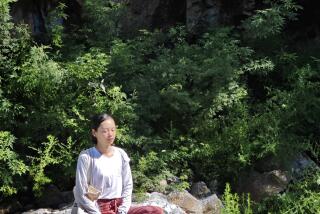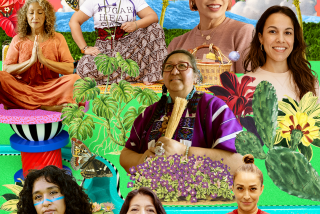At India’s lauded Ananda spa, a restless <i>vata dosha </i>learns to relax
NARENDRA NAGAR, India — I am a dharma disaster, a chakra calamity.
I cannot meditate. My inner hamster is a maniac, and my legs refuse to cross for that long. So when the saried woman with the serene kohled eyes tells me that I have a private meditation session scheduled, I inform her that I would prefer another herbal bundle massage — my third for the week. She laughs.
“You are a vata dosha,” she says in her lilting Indian accent. “We know you do not like sitting still. This is a lying-down meditation. Your job is only to be guided by the instructor’s voice and remain in the state between sleep and wakefulness.” This I think I can do.
I am in the foothills of the Himalayas in India’s northern Uttarakhand state at the remote Ananda Spa. Ananda is a retreat based on ayurvedic medicine, therapies and cuisine, as well as various styles of meditation and yoga. It has been voted the world’s best destination spa several times by readers of Condé Nast Traveler and won favor with the celeb set the world over.
But I’m the least likely person to come here, which is why I need it, according to my friend Susan Burks, who decades ago lived in ashrams and consulted gurus and has accompanied me here.
Ananda is perched 11 miles above the holy town of Rishikesh, apparently the birthplace of yoga and the town in which the Beatles famously spent time dressed in kurta pajamas studying transcendental meditation and writing music. After a 45-minute plane ride from Delhi and a one-hour drive from the Dehradun airport, through Rishikesh, over the rushing waters of the Ganges River and up through the forests, we arrived at the 4,500-foot elevation and Ananda in the Himalayas. Outside, a phalanx of beautifully turbaned staff greeted us with namaskar.
I’ll admit to a flash of disappointment when we pulled into the driveway. The Narendra Palace, the grounds of which host the spa, looked dilapidated and abandoned. The spa’s reception area, in the viceroy’s mansion behind the palace, was a throwback to 1930s Raj, almost shabby when my expectation was the wow of the world’s best spa.
My room in the guest building down the hill, although comfortable and elegant with a 180-degree view of the Ganges, was simple by design. (There are, however, five luxury suites and three private multiroom villas available.)
A week later I was ashamed of my superficial original impressions. Ananda is not about materialism. It is a spiritual and physical retreat, a place to be nurtured and reminded that balance, gratitude and wellness are tantamount. It’s not about the design of the sofa but about how at peace you are while sitting on it.
Ananda has some sort of crazy magic like no other place I’ve been.
Before arriving, I received a questionnaire with program options: ayurvedic rejuvenation, weight management, detox, yogic or stress management. I chose the ayurvedic, imagining it would involve prone positions and warm oil treatments. Before the warm oil flowed, however, I was required to consult the resident ayurvedic doctor, trained in the many-thousand-year-old art of Indian natural medicine using herbal compounds, oils, special diets, meditation and exercise suited specifically to a body type.
Half an hour later, I left with my world rocked, categorized as a vata dosha, which dictated my physical and behavioral self. Reading the vata characteristics was uncanny — typically thin, not much muscle, dry skin, creative, cold hands and feet, restless, active, quick learner but forgets easily, insomniac tendencies, variable appetite, thrives on irregular routines, speaks quickly and gesticulates, becomes “spaced-out” frequently — and on it went, describing, well, me.
Finally, somebody understood.
Drifting through the marigold-decorated hallways of the calming 24,000-square-foot Ananda Spa, I was greeted by a glowing woman who handed me my daily schedule of treatments, sessions and optional classes. One of the beautiful things about Ananda is that the price (less than most American high-end spas) includes at least three treatments a day, and you can always add from the menu of more than 80 Eastern- and Western-style healings. They put together a spa program that they think is best for you and your dosha — vata, pitta or kapha — and recommend you stick to it, although you can switch.
This is not a place of privation or austerity. If you really must eat the dessert, OK, eat it. If you really need that glass of wine, you can order it (go ahead, pollute your body, no judgment), and if you really don’t want liquid ghee poured in your eyes, well, they won’t make you.
I surrendered to everything recommended because I was here to wade deep out of my comfort zone. I had only ayurvedic treatments, drank no alcohol and ate off the vata menu (in a moment of weakness I ordered a meat curry). The food was some of the most delicious I’ve ever been served. You stare, aghast, at the diminutive portion they put in front of you, yet somehow you walk away replete. It’s part of the Ananda magic. If you think it, it is. If you need something, it appears. If you want to talk to someone, there he or she is beside you. If you wish to achieve something, you probably will.
Ayurvedic spa treatments use two therapists working on the body simultaneously. My favorite therapies were choorna swedana, a heated herbal poultice massage for “increasing circulation, eliminating toxins, relieving muscle and joint pain and sports injuries,” and the signature shirodhara, or warm oil poured slowly on the forehead in a continuous stream to “revitalize the mind, improve memory, normalize sleep and lower blood pressure.”
Next time I might skip the ghee-in-the-eye treatment, but everything once was my approach.
Ananda is set on 100 acres of mountain forests, flower gardens, manicured lawns, reflecting ponds and marble meditation temples, so when not recumbent you are encouraged to walk the grounds. There is no need to pack much more than shoes, sweater and a toothbrush for Ananda. Daily, you are given fresh white cotton kurta pajamas — a long shirt and baggy pants — and although you don’t have to wear them, they are the ultimate in comfort and, incredibly, everyone looks fabulous in them.
I even wore mine when I went into Rishikesh to attend the aarti ceremony on the banks of the holy Ganges River, a fire offering to the goddess Ganga led by saffron-robed Indian students of a local ashram.
I had my forehead anointed with ash and red turmeric and was honored to be invited to hold a lamp as the muddy, swift river flowed over my feet. Although all comers can watch, the invitation to join the ceremony probably had something to do with Dinesh Dhanai, a local river rafting and mountain guide who takes Ananda guests on excursions and who introduced Susan and me to the ritual.
We enjoyed Dhanai’s company so much that we accompanied him on a hike through the alpine forest to Kunjapuri Temple several thousand feet above the spa with a view all the way to Tibet. Hindu priests live, worship, feed the local monkeys and welcome pilgrims here.
Inside the tiny temple sat a young priest who bade me sit on a rug in front of him while he anointed my forehead and tied a red string around my wrist. The string, I was told, was a blessing and would remind me to be brave, to be honorable and to feel protected.
Three months later the string is still tied around my left wrist. It’s tattered and faded, but every time I think to cut it off I can’t do it.
My vata self seems to need this string to remind me of what I learned at Ananda: to breathe a little deeper, to engage in yoga nidra frequently (the lying-down meditation at which, it turns out, I am quite accomplished) and to believe in the Ananda magic.
More to Read
Sign up for The Wild
We’ll help you find the best places to hike, bike and run, as well as the perfect silent spots for meditation and yoga.
You may occasionally receive promotional content from the Los Angeles Times.






